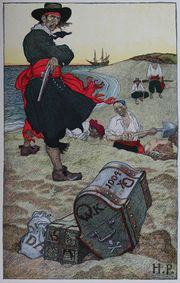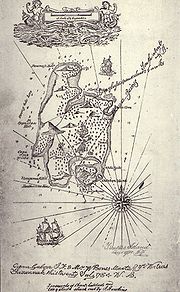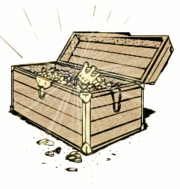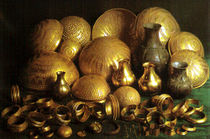Treasure
Treasure (from Greek θησαυρος; thesaurus, meaning "a treasure of the chest", is a cognate) is a concentration of riches, often one which is considered lost or forgotten until being rediscovered. Some jurisdictions legally define what constitutes treasure, such as in the British Treasure Act 1996.
The phrase "blood and treasure" or "lives and treasure" has been used to refer to the human and monetary costs associated with various (usually state-initiated) endeavours such as space exploration or war.
Contents |
Treasure hunting
Searching for hidden treasure is a common theme in legend and fiction, real-life treasure hunters also exist, and can seek lost wealth for a living.

Buried treasure
A buried treasure is an important part of the popular beliefs surrounding pirates. According to popular conception, pirates often buried their stolen fortunes in remote places, intending to return for them later (often with the use of treasure maps).
One of the more famous pirates known to have done this was William Kidd[2], who is believed to have buried at least some of his wealth on Long Island before sailing into New York. Kidd had originally been commissioned as a privateer for England, but his behaviour had strayed into outright piracy, and he hoped that his treasure could serve as a bargaining chip in negotiations to avoid punishment. His bid was unsuccessful, however, and Kidd was hanged as a pirate.
In English fiction there are three well known stories that helped popularize the myth of buried pirate treasure[3]: "The Gold-Bug" by Edgar Allan Poe, "Wolfert Webber" by Washington Irving and Treasure Island by Robert Louis Stevenson. They differ widely in plot and literary treatment but are blood kin from the common ancestor of the William Kidd legend.[4] Stevenson's Treasure Island was directly influenced by Irving's "Wolfert Webber", Stevenson saying in his preface "It is my debt to Washington Irving that exercises my conscience, and justly so, for I believe plagiarism was rarely carried farther.. the whole inner spirit and a good deal of the material detail of my first chapters.. were the property of Washington Irving."[4]
However, there are a number of reports of supposed buried pirate treasure that surfaced much earlier than these works, which indicates that at least the idea was around for more than a century before those stories were published. For example, some underground passages and structures on Oak Island (in Nova Scotia) have supposedly been excavated extensively since 1795 in the belief that one or more pirate captains had stashed large amounts of loot there. These excavations were said to have been prompted by still older legends of buried pirate treasure in the area. No treasure has ever been found.

Treasure maps
A treasure map is a variation of a map to mark the location of buried treasure, a lost mine, a valuable secret or a hidden location. More common in fiction than in reality, "pirate treasure maps" are often depicted in works of fiction as hand drawn and containing arcane clues for the characters to follow. Regardless of the term's literary use, anything that meets the criterion of a "map" that describes the location of a "treasure" could appropriately be called a "treasure map."
Copper scroll
One of the earliest known instances of a document listing buried treasure is the copper scroll, which was recovered among the Dead Sea Scrolls near Qumran in 1952. Believed to have been written between 50 and 100 AD, the scroll contains a list of 63 locations with detailed directions pointing to hidden treasures of gold and silver. The following is an English translation of the opening lines of the Copper Scroll:[5]
1:1 In the ruin which is in the valley of Acor, under
1:2 the steps leading to the East,
1:3 forty long cubits: a chest of silver and its vessels
1:4 with a weight of seventeen talents. KEN
Thus far, no item mentioned in the scroll has been found. Scholars remain divided on whether the copper scroll represents real burials, and, if so, the total measurements and the owners.
Pirates
Although buried pirate treasure is a favorite literary theme, there are very few documented cases of pirates actually burying treasure, and no documented cases of a historical pirate treasure map.[2] One documented case of buried treasure involved Francis Drake who buried Spanish gold and silver after raiding the train at Nombre de Dios -- after Drake went to find his ships, he returned six hours later and retrieved the loot and sailed for England. Drake did not create a map.[2] Another case in 1720 involved British Captain Stratton of the Prince Eugene who, after supposedly trading rum with pirates in the Caribbean, buried his gold near the mouth of the Chesapeake Bay. One of his crew, Morgan Miles, turned him in to the authorities, and it is assumed the loot was recovered. In any case, Captain Stratton was not a pirate, and made no map.[2]
The pirate most responsible for the legends of buried pirate treasure was Captain Kidd. The story was that Kidd buried treasure from the plundered ship the Quedah Merchant on Gardiner's Island, near Long Island, New York, before being arrested and returned to England, where he was put through a very public trial and executed. Although much of Kidd's treasure was recovered from various people who had taken possession of it before Kidd's arrest (such as his wife and various others who were given it for safe keeping), there was so much public interest and fascination with the case at the time, speculation grew that a vast fortune remained and that Kidd had secretly buried it. Captain Kidd did bury a small cache of treasure on Gardiner's Island in a spot known as Cherry Tree Field; however, it was removed by Governor Bellomont and sent to England to be used as evidence against him.[6] Over the years many people have tried to find the supposed remnants of Kidd's treasure on Gardiner's Island and elsewhere, but none has ever been found.[2]
People have claimed to have discovered maps and other clues that led to pirate treasure, or claim that historical maps are actually treasure maps. These claims are not supported by scholars.
The Story Of El Dorado
In 1595, the English explorer Sir Walter Raleigh set out to find the legendary city of El Dorado.[7] The city was never found but Raleigh wrote at length about his venture to South America in which he claimed to have come within close proximity of "the great Golden Citie of Manoa (which the Spaniards call El Dorado)."[7] Despite the fact that his narrative was quite unrealistic — it described a tribe of headless people, for example — his reputation commanded such respect that other cartographers apparently used Raleigh's map as a model for their own. Cartographer Jodocus Hondius included El Dorado in his 1598 map of South America, as did Dutch publisher Theodore de Bry.[7] The city remained on maps of South America until as late as 1808[7] and spawned numerous unsuccessful hunts for the city.
In fiction
Treasure maps have taken on numerous permutations in literature and film, such as the stereotypical tattered chart with an over-sized "X" (as in "X marks the spot") to denote the treasure's location, first made popular by Robert Louis Stevenson in Treasure Island (1883), a cryptic puzzle (in Edgar Allan Poe's "The Gold-Bug" (1843)), or a tattoo leading to a dry-land paradise as seen in the film Waterworld (1995).
Literature
The treasure map may serve several purposes as a plot device in works of fiction:
- Motivation, causing the characters to begin a quest
- Plot exposition, explaining in a concise way where the characters must go on their quest
- To illustrate, at various points in the story, how far the quest has progressed.
- To provide conflict where, for example, evildoers attempt to capture the map from the protagonists
While Robert Louis Stevenson is associated with popularizing the treasure map—and the archetypal X to mark the spot—with pirates in Treasure Island,[2] he is not the first. Author James Fenimore Cooper's earlier 1849 novel The Sea Lions, is a tale that begins with the death of a sailor who has left behind "two old, dirty and ragged charts" which lead to a seal-hunting paradise in the Antarctic as well as a location in the West Indies where pirates have buried treasure, a plot similar to Stevenson's tale.
Film
In the 1985 film The Goonies, an old treasure map leads to the secret stash of a legendary 17th century pirate, an almost exact imitation of Stevenson's plot in Treasure Island. In the 2004 film National Treasure, a treasure map becomes the source of the quest itself. In the 1994 comedy City Slickers 2: The Legend of Curly's Gold, a treasure map is made by criminals who are analogous to modern day pirates. In the film Waterworld, an extremely vague and cryptic treasure map has been tattooed on the back of the child character Enola. This map leads the characters to dry-land, which in the context of the film, is a treasure.
Treasure chest

A treasure chest is a common element in modern fiction, gaming and video gaming. The primary idea behind the treasure chest is a romantic one, that pirates and other idealized criminals faced constant persecution and lived such fast-paced lives that they sometimes had to quickly dispose of their ill-gotten gain to return to and reclaim later. Hence, the idea that treasure could easily be held in a wooden chest and buried, with a treasure map to guide the burier (or a lucky recipient of the map) back, was born.
See also
Spanish treasure lost from the Spanish treasure fleet consisted of gold, silver, jewels (especially emeralds) and also cocoa, vanilla and brazilwood.[8]
- Hoard
- Treasure trove
- List of treasure hunters
- Leprechaun
- Lost mines
- Metal detector
- Romanian Treasure
- Thirteen Treasures of the Island of Britain
- Confederate gold
- Schatzkammer
- Środa treasure
Legends
- See Category:Treasure troves
- Lost mines
- Oak Island
- Treasure of the Knights Templar
- Rennes le Château
- Štěchovice Treasure of the Czech Republic
- Beale treasure
- RMS Republic (1903)
- Amber room
- Treasure of the llanganatis
- Lost Dutchman's Gold Mine
- Lost ship of the desert
- Preslav treasure
- Treasure of the pirate Jean Lafitte
- Victorio Peak
- Yamashita's Gold
In film and literature
- Nibelungenlied
- The treasure of Monte Cristo (1844)
- Treasure Island (1882)
- The Maltese Falcon (1930)
- Treasure Island (1934)
- The Treasure of the Sierra Madre (1948)
- The Treasure series (1958)
- Raiders of the Lost Ark (1981)
- Indiana Jones and the Temple of Doom (1984)
- Indiana Jones and the Last Crusade (1989)
- The Goonies (1985)
- National Treasure (2004)
- National Treasure: Book of Secrets (2007)
- One Piece
- Fool's Gold (2008)
- It's a Mad, Mad, Mad, Mad World
- Into the Blue (2005)
- Pirates of the Caribbean: The Curse of the Black Pearl (2003)
- Pirates of the Caribbean: Dead Man's Chest
- Pirates of the Caribbean: At World's End
- The Secret of the Unicorn
- Red Rackham's Treasure
- The Adventures of Tintin: Secret of the Unicorn
- Treasure: In Search of the Golden Horse (1984, film, book)
References
- ↑ "RESOLUCIÓN de 7 de enero de 2003, de la Dirección General de Patrimonio Artístico de la Consejería de Cultura y Educación, por la que se incoa expediente de declaración de bien de interés cultural a favor de la colección arqueológica del Tesoro de Villena. [January 7, 2003, RESOLUTION of the General Direction on Artistic Heritage of the Culture and Education Council, which opens a file on the declaration as Good of Cultural Interest (BIC) the archaeologic collection known as Treasure of Villena]" (in Spanish) (pdf). [Spanish] State Official Bulletin (BOE) (Madrid: Spanish Government) (49): 7798–7802. 1 2003. http://www.boe.es/boe/dias/2003/02/26/pdfs/A07798-07802.pdf. Retrieved December 6, 2009. "Desde el punto de vista histórico, artístico y arqueológico, el Tesoro de Villena constituye un «unicum», un depósito no normalizado, por su peso y contenido (A. Perea). De hecho, se trata del segundo tesoro de vajilla áurea más importante de Europa, tras el de las Tumbas Reales de Micenas en Grecia (A. Mederos). (From a historic, artistic and archaeological point of view, the Treasure of Villena constitues a "unicum", a non-normalised deposit, according to its weight and content (A. Perea). In fact, it is the second most important golden tableware finding in Europe, after that of the Royal Graves in Mycenae in Greece (A. Mederos))"
- ↑ 2.0 2.1 2.2 2.3 2.4 2.5 *David Cordingly (1995). Under the Black Flag: The Romance and the Reality of Life Among the Pirates. ISBN 0-679-42560-8.
- ↑ Paine, pp. 27–28
- ↑ 4.0 4.1 Paine, pg. 28
- ↑ García Martínez, Florentino and Eibert J. C. Tigchelaar, The Dead Sea Scrolls: Study Edition, Paperback ed. 2 vols., (Leiden and Grand Rapids: Brill and Eerdmans, 2000).
- ↑ The Pirate Hunter: The True Story of Captain Kidd, pg. 241, The Pirate Hunter: The True Story of Captain Kidd, pg. 260
- ↑ 7.0 7.1 7.2 7.3 *Miles Harvey (2000). The Island of Lost Maps: A True Story of Cartographic Crime. ISBN 0-375-50151-7.
- ↑ Cynthia Zarin, "Green dreams: A mystery of rare, shipwrecked emeralds", The New Yorker, November 21, 2005, pp. 76–83
|
|||||||||||||||||||||||||||||||||||||||||
